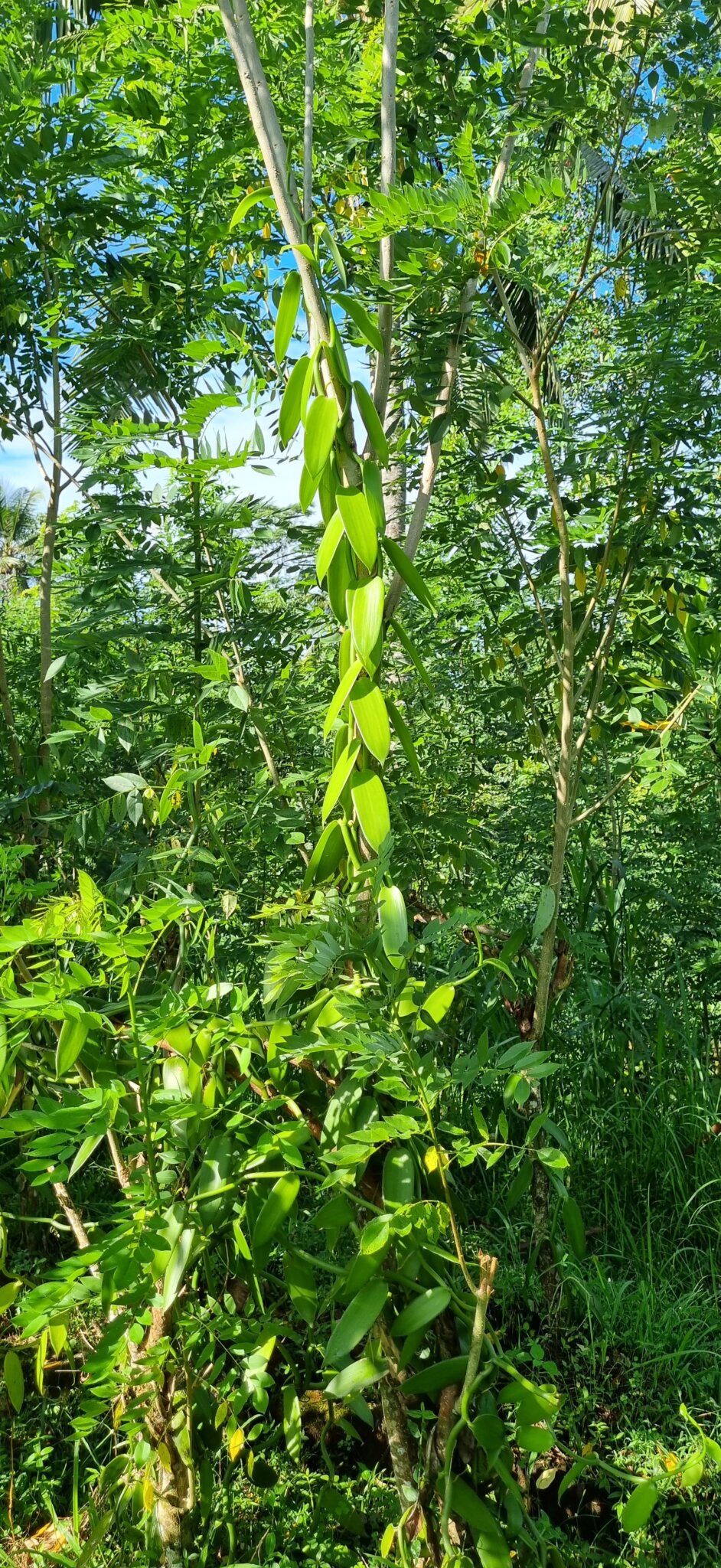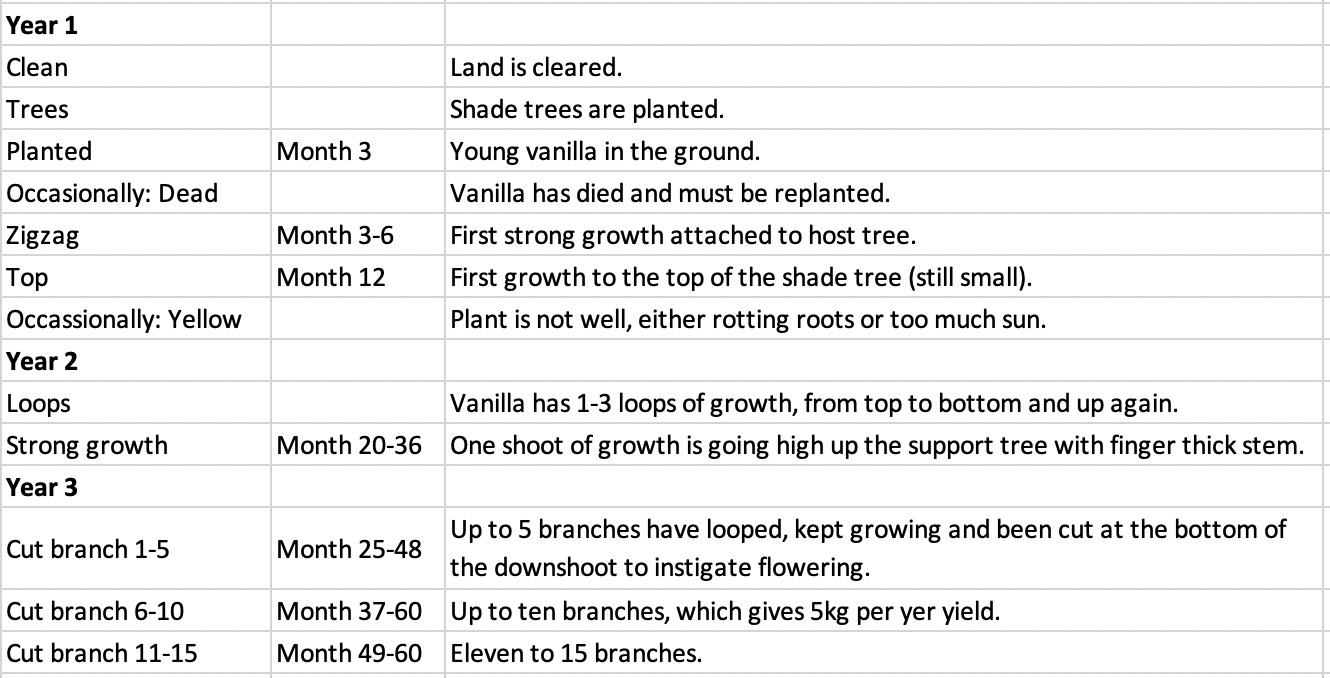
Growing vanilla is all about controlling moisture and light. But let us look at the various stages of a vanilla plant’s life.

This is the expected growth pattern. Very wet seasons can delay this, and overly dry as well. Many good vanilla areas are just dry and will never get so many cut branches as we target.
Every cut branch will produce flowers from the leaf nodes, providing it is big and thick enough. Not all at once – they can take 3 years to develop, usually about 3 racemes a year. (A raceme is a bunch of flowers together from one leaf node.) We forecast 8-10 beans per raceme. Each bean will weigh an average of 17g.
So, one raceme gives 170g. 3 give 510g. So, we need two cut branches per plant to produce 1kg per plant.
10 cut branches will give 5kg which is the target per plant. However, only fit, healthy plants can produce this much, with lots of green leaves producing plenty of chlorophyll and sugar.
How do we ensure we get to this stage?
First, we must look at the drainage. A good root system on the host tree will enable the vanilla to follow the roots down, but we also need a rich, well-drained loam on the top. This provides food for the vanilla as well as the host. But this is no good if the planting is done on flat ground. The very soil must drain away with the water table down a good few metres. Or, it can be on a slope, with the rows stretching downslope, though they can be at an angle.
Compost is excellent, and make sure you know what has gone into the compost. Cow manure will add potassium and certain plants phosphorous, which are essential nutrients. Note, these should only be added in the run up to the flowering season. When you need strong growth, more nitrogen! When adding compost, never add it wet or too close to the roots. Both will kill roots. Wet on the roots will kill the entire plant. We don’t bother adding compost during the wet season. It would just get washed away.
Another thing we should mention is wind. Vanilla loves wind, not too much but a good blow brings nutrition to the aerial roots and dries out roots that got too wet. Vanilla can withstand heavy rain if there is also lots of wind. This is the main reason not to plant too close – though the spacing really depends on the shade tree. More on this later.
But what vanilla loves most of all is height. Given enough height, nothing else matters! Of course, to vanilla, enough height is 50 metres which is a bit difficult to cultivate! After the plant has looped 2-3 times, we let one shoot run up a branch. If it gets thick, they can all go up. When they get about 5m up, they should be huge, as thick as your thumb, never mind your finger. At this stage, we can cut the branch it runs up and the clinging roots, allowing the vanilla branch to hang down to the ground and start up again. When this gets to the top again, with its own roots in the ground, we can cut the bottom of the down branch. This creates a new, strong vanilla plant which will continue to loop (why these properly managed plants become perpetual) and stresses the cut branch. With nowhere for the good strong sap to go, it will produce flowers as humidity and temperature rise at the beginning of the wet season.
Remember I said that each cut branch will produce 3 racemes per year for 3 years? That is assuming that a cut branch has 9 leaves. When you increase the height, you increase the numbers of leaves. We have some with 20 leaves. Theoretically, this will double production, but I am not sure about getting 10kg. There was a farmer who claimed 30kg, and we believe him. But he ran his vanilla up a big tree and had to climb it to pollinate it. We don’t think this is commercially viable.
Nevertheless, we do need to come up with solutions for higher support trees. We do plant with enthusiasm against slopes, so the farmer can go uphill to reach the top flowers. But on flatter ground, we are still experimenting. Tools with extensions are fine until it comes to flowering. We shall need lots of small stepladders in the gardens, I think!
I should mention that there are people who say you will never get more than 2-3 kg of green beans from a vanilla plant, and think they are absolutely right for their locality. I know that is the expected yield in North Bali, where it is very dry. They will get a harvest when we are washed away, but their harvest will always be small. The same applies to many of the locations where vanilla is grown. When it is so dry, they cannot even grow the vanilla higher.
Our standard growing tree is the Gliricidia, which is a nitrogen fixer, grows fast and takes heavy pruning. Gliricidia can be planted as close as 1m apart. We also have vanilla up avocado, tree fern, mulberry, Singapore cherry, sugar palm, mango, oil palm, frangipani and many others. Each of these requires different spacing, and whether or not it is better than Gliricidia depends on the yield after 5 years…
Rex Sumner
Chairman at PT Royal Spice Gardens
Royal Spice Gardens is an Indonesian Foreign Investment Company, in Indonesia known as a Perusahaan Modal Asing (PMA).
NIB Licence number 0220100502286. NPWP: 94.830.504.0- 905.000.
PT Royal Spice Gardens Indonesia, Jl. Raya Pejeng, Tampaksiring, Gianyar, Bali 80552, Indonesia
Website by Simia Solutions / Cre8 Design Studio
Powered by Pak Kriss’s Compliance Framework.
Even in uncertain times, credible, stable & realistic opportunities are available for the astute investor.
Get the edge by obtaining clear, concise and rapid information. Fill out the form to receive our latest prospectus!